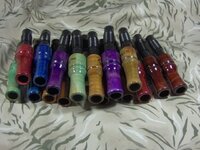Friction Polish and wax - they wear OFF. regular re-application of waxing is necessary. If you like that look, that is OK.
Most people who get into pen turning from flat work or bowl turning do not see a difference between those arts vs (wood) pen making. But there is a fundamental difference between flat work, bowl turning vs pens that requires some examination/thinking.
Do you want your pens to have stained hand grim on it 6 months to a year down the road? Bowls and furniture are not handled 5 to 10 times a day, often with caustic sweaty palms, placed in caustic humid shirt pockets, or into pants pockets with change or a purse with loose whatever. They are not left in vehicles that get 130° heat in the summer or taken from a warm environment to freezing temps in a matter of seconds. Pens ARE!
That is the difference that pens go through that bowls and fine woodworking / flat furniture do not. Do not expect the same finishes to protect pens the same way they do bowls and flatwork.
That said, French polish, other finishes, waxes look good on pens. But don't expect it to do the same - different friction polishes give different results too. There are people here that keep their pens exquisite and keep them clean. This happens more with the more expensive pens and particularly with fountain pens - when the prices begin to sell above the $500.00 - $1000.00 range. (People who pay those prices value their pens and will usually go to the trouble of cleaning them at least weekly and often daily., but people with lesser priced pens very rarely do.)
There are other finishes, but they take time - some polyurethanes, some epoxies, some lacquers, and others. Each has its own positive characteristics and its own drawbacks.
CA is a fast finish and is hard and durable. And you have run into the problem with CA that many have - CA allergies. I applied CA for 2 years and suddenly I developed a severe allergy within a matter of a few weeks. I tried other lasting finishes. I loved that I could make a pen in an hour or so and finish it in 15 - 30 minutes with a hard glass shine with CA, but with the other finishes, suddenly it was 30 - 45 minutes on a pen and 24 hours to finish. The disproportion made me re-think my finish. Some finishes cure/dry enough in 30 minutes to touch, but require 24 hours to cure enough to handle regularly.
There are several people here, and one in particular (Manupropria), who takes about a month on the "finish" of a pen, but he starts maybe six or a dozen or so a day.
As for me, I tried different finishes and finally came up with the need for a respirator and a Dust Collection system on my lathe. Between those two, I circumvented the CA allergies and could continue my CA finish. I still like lacquer in some circumstances, mainly when I get a whim to do it that way. :wink:
It comes down to what YOU want to do and the results that you are willing to accept. I am offering some very basic insights on the positives and negatives of different finishes.
I second what Louie and Lenny wrote above and I didn't cover those. They are right on!

